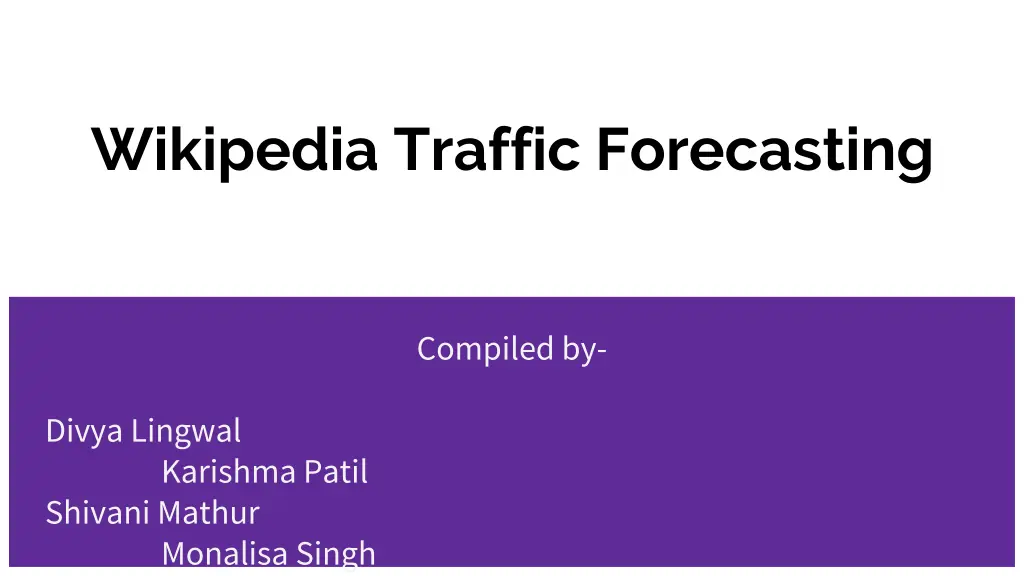
Wikipedia Traffic Forecasting Project
"Explore the Wikipedia Traffic Forecasting Project designed by Divya Lingwal, Karishma Patil, Shivani Mathur, and Monalisa Singh. The project aims to predict future web traffic for thousands of Wikipedia articles using time-series analysis. Learn about data cleaning, transformation, and forecasting methods used in this insightful project."
Download Presentation

Please find below an Image/Link to download the presentation.
The content on the website is provided AS IS for your information and personal use only. It may not be sold, licensed, or shared on other websites without obtaining consent from the author. If you encounter any issues during the download, it is possible that the publisher has removed the file from their server.
You are allowed to download the files provided on this website for personal or commercial use, subject to the condition that they are used lawfully. All files are the property of their respective owners.
The content on the website is provided AS IS for your information and personal use only. It may not be sold, licensed, or shared on other websites without obtaining consent from the author.
E N D
Presentation Transcript
Wikipedia Traffic Forecasting Compiled by- Divya Lingwal Karishma Patil Shivani Mathur Monalisa Singh
Introduction It is important to predict the websites future traffic volume, in order to provide a quality of service to the users. We are implementing the process of Data analysis for Wikipedia Traffic using the time-series approach. Predicting the future behaviour of time series for Wikipedia articles.
Problem Statement Wikipedia has large number of potential users viewing approximately 145,000 Wikipedia articles. It is essential to deal with the problem of overload, for that we need to predict future web traffic for thousands of Wikipedia articles.
Project Description AIM: To help predict future views of Wikipedia articles Using Time series analysis which encapsulates problems like analysis, inference, classification and forecast. We are using R programming language. Used both Time series analysis and forecasting techniques. Analyzed all 4 components of Time series. Datasets used: 1. User view data, each column is a date and each row is an article 2. Mapping between article names and a unique ID column
Brief Introduction of Wikimedia and Mediawiki MEDIAWIKI WIKIMEDIA
Procedure Data Cleaning Data transformation Time Series extraction Parameter extraction Forecasted Methods
Data Cleaning Finding the missing values-8% missing values Few missing values. These seem to be important so we did not remove them
Data Transformation Split data into 2 parts: Page and Dates
Data Transformation contd Divided the article info from *wikipedia*, *wikimedia*, and *mediawiki*
Data Transformation contd Tokenized the pages into different columns Access: Desktop, Mobile-web. All-access Agent: All-agents, Spider Locale: wikmed, medwik, codes(zh,en,ja,es,fr) for wikipedia
Experimental Evaluations Un-Smoothened Graph Need to smooth it to check for better patterns and trends
Data Overview Comparison of articles in 7 languages: German, Chinese, English, Spanish, French, Japanese, Russian. Higher frequency for english articles Slightly higher number of mobile viewers than Desktop viewers
Calculating Time Series parameters To analyze the time series data we need to find the following parameters: Mean Standard Deviation Amplitude Slope Linear model for slope: Views~ pages+dates
Individual observations with extreme parameters Finding out the values with highest views
Plotting time series for shorter duration Plotting time series for 2-month duration
Forecasting Approach In our project we forecast 2 months data and measure the prediction accuracy by keeping a holdout sample of 60 days from our forecast data. We have done this by using autoregressive integrated moving average(ARIMA) model. This consists of three parts( parameterized by indices p, d, q) as ARIMA(p, d, q): Auto-regressive/p: pindicates the range of lags. Integrated/d: d is a differencing parameter, which gives us the number of times we are subtracting the current and the previous values of a time series. Moving average/q: qgives us the number of previous error terms to include in the regression error of the model.
Future Work Seasonality component Holt- Winters method
